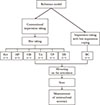1. Freilich MA, Altieri JV, Wahle JJ. Principles for selecting interocclusal records for articulation of dentate and partially dentate casts. J Prosthet Dent. 1992; 68:361–367.
2. Ockert-Eriksson G, Eriksson A, Lockowandt P, Eriksson O. Materials for interocclusal records and their ability to reproduce a 3-dimensional jaw relationship. Int J Prosthodont. 2000; 13:152–158.
3. Anup G, Ahila SC, Vasanthakumar M. Evaluation of dimensional stability, accuracy and surface hardness of interocclusal recording materials at various time intervals: an in vitro study. J Indian Prosthodont Soc. 2011; 11:26–31.
4. Mullick SC, Stackhouse JA Jr, Vincent GR. A study of interocclusal record materials. J Prosthet Dent. 1981; 46:304–307.
5. Savabi O, Nejatidanesh F. Interocclusal record for fixed implant-supported prosthesis. J Prosthet Dent. 2004; 92:602–603.
6. Wicks R, Ahuja S, Jain V, Ferreira CF. A technique to create an interocclusal bite registration using in situ implant healing abutments. J Tenn Dent Assoc. 2013; 93:47–49.
7. Monzavi A, Alikhasi M, Taghavi F. Occlusal recording components for dental implant-supported prostheses. J Dent (Tehran). 2012; 9:76–78.
8. Tejo SK, Kumar AG, Kattimani VS, Desai PD, Nalla S, Chaitanya KK. A comparative evaluation of dimensional stability of three types of interocclusal recording materials-an in-vitro multi-centre study. Head Face Med. 2012; 8:27.
9. Chun JH, Pae A, Kim SH. Polymerization shrinkage strain of interocclusal recording materials. Dent Mater. 2009; 25:115–120.
10. Roh JY, Kamg MK, Shim SY, Kim KN, Kim KM. Evaluation of physical properties of polyvinylsiloxane interocclusal recording materials. Res Soc Dent Mater. 2006; 33:301–307.
11. Ghazal M, Ludwig K, Habil RN, Kern M. Evaluation of vertical accuracy of interocclusal recording materials. Quintessence Int. 2008; 39:727–732.
12. Gibbs SB, Versluis A, Tantbirojn D, Ahuja S. Comparison of polymerization shrinkage of pattern resins. J Prosthet Dent. 2014; 112:293–298.
13. Müller J, Götz G, Hörz W, Kraft E. An experimental study on the influence of the derived casts on the accuracy of different recording materials. Part I: Plaster, impression compound, and wax. J Prosthet Dent. 1990; 63:263–269.
14. Park HY, Chang IT, Kim KN. An experimental study on the accuracy of interocclusal recording materials. J Korean Acad Prosthodont. 1990; 28:91–108.
15. Breeding LC, Dixon DL, Kinderknecht KE. Accuracy of three interocclusal recording materials used to mount a working cast. J Prosthet Dent. 1994; 71:265–270.
16. Park JY, Kim HY, Kim JH, Kim JH, Kim WC. Comparison of prosthetic models produced by traditional and additive manufacturing methods. J Adv Prosthodont. 2015; 7:294–302.
17. Müller J, Götz G, Hörz W, Kraft E. Study of the accuracy of different recording materials. J Prosthet Dent. 1990; 63:41–46.
18. Iwaki Y, Wakabayashi N, Igarashi Y. Dimensional accuracy of optical bite registration in single and multiple unit restorations. Oper Dent. 2013; 38:309–315.
19. Tripodakis AP, Vergos VK, Tsoutsos AG. Evaluation of the accuracy of interocclusal records in relation to two recording techniques. J Prosthet Dent. 1997; 77:141–146.
20. Lee H, So JS, Hochstedler JL, Ercoli C. The accuracy of implant impressions: a systematic review. J Prosthet Dent. 2008; 100:285–291.
21. Parker MH, Cameron SM, Hughbanks JC, Reid DE. Comparison of occlusal contacts in maximum intercuspation for two impression techniques. J Prosthet Dent. 1997; 78:255–259.
22. Lassila V. Comparison of five interocclusal recording materials. J Prosthet Dent. 1986; 55:215–218.
23. Michalakis KX, Pissiotis A, Anastasiadou V, Kapari D. An experimental study on particular physical properties of several interocclusal recording media. Part II: Linear dimensional change and accompanying weight change. J Prosthodont. 2004; 13:150–159.
24. Millstein PL, Kronman JH, Clark RE. Determination of the accuracy of wax interocclusal registrations. J Prosthet Dent. 1971; 25:189–196.
25. Vergos VK, Tripodakis AP. Evaluation of vertical accuracy of interocclusal records. Int J Prosthodont. 2003; 16:365–368.
26. Ghazal M, Albashaireh ZS, Kern M. The ability of different materials to reproduce accurate records of interocclusal relationships in the vertical dimension. J Oral Rehabil. 2008; 35:816–820.
27. Mojon P, Oberholzer JP, Meyer JM, Belser UC. Polymerization shrinkage of index and pattern acrylic resins. J Prosthet Dent. 1990; 64:684–688.
28. Müller J, Götz G, Hörz W, Kraft E. An experimental study on the influence of the derived casts on the accuracy of different recording materials. Part II: Polyether, acrylic resin, and corrected wax wafer. J Prosthet Dent. 1990; 63:389–395.
29. Millstein PL, Hsu CC. Differential accuracy of elastomeric recording materials and associated weight change. J Prosthet Dent. 1994; 71:400–403.
30. Breeding LC, Dixon DL. Compression resistance of four interocclusal recording materials. J Prosthet Dent. 1992; 68:876–878.
31. Odman PA, Jemt TM. Accuracy of impression materials in a semi-clinical model. Dent Mater. 1988; 4:64–67.
32. Klineberg I, Jagger R. Occlusion and clinical practice: an evidence-based approach. Edinburgh: Wright/Elsevier;2004. p. 83–89.
33. Davies SJ, Gray RJ, Linden GJ, James JA. Occlusal considerations in periodontics. Br Dent J. 2001; 191:597–604.












 PDF
PDF ePub
ePub Citation
Citation Print
Print




 XML Download
XML Download